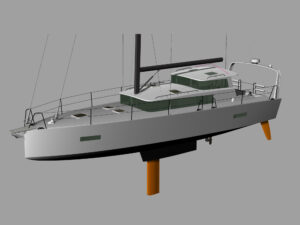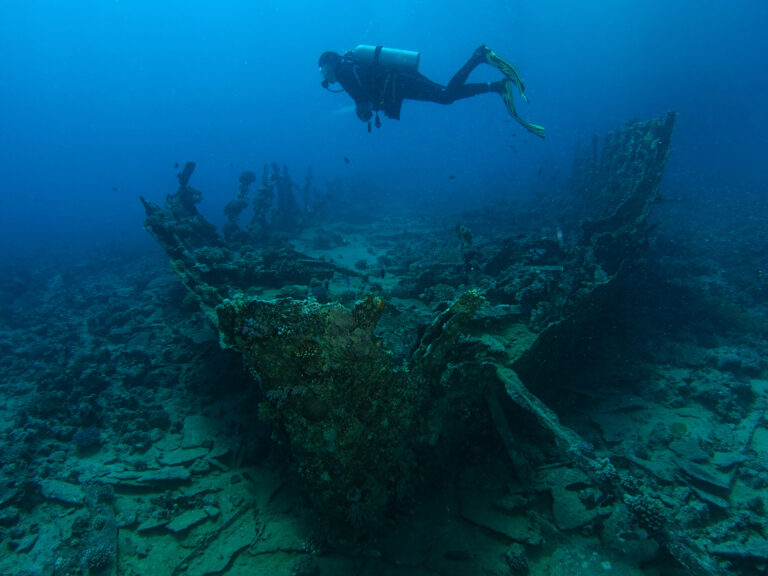
I’m cheap but not chintzy. I believe that I can do really cool, really fun things on my boat (for pennies) that make it safer and more seaworthythan the expensive, gold-plated boat anchored next to mine. Plus, because I’ve almost never worked ashore, I whip up these cruising gizmos on a microbudget. Saving money on such projects—and being able to spend it while cruising the world—is really important to me.
Example: stepping masts. I purchased my first vessel as a teenager in Chicago. It didn’t have a mast. When I finally managed to finagle a Sitka spruce spar, I couldn’t afford a crane to step it. Not a problem: I laid it on deck on sawhorses and drove my boat under the bridge at the Lake Shore Drive S-turns in Chicago. At rush hour (to discourage pesky questions), my father and some friends pulled over into the breakdown lane and tossed over a block-and-tackle. Within minutes, they hoisted the heavy wooden mast in place—and we were gone before the Chicago police knew what happened.
Thus, with all my vessels and in all my days, I’ve never once paid to have a mast stepped or unstepped. Why would I?
Alas, in the Virgin Islands, bridges are few and far between, but large sailing vessels are a dime a dozen. Thus, just before our first circumnavigation, when I wanted to pull the mast on my Hughes 38 Wild Card, I just jammed her between a Little Harbor 82 named Tala and a Hinckley 65 named Skeets. Both were anchored in Hurricane Hole, St. John, for happy hour. Before their skippers were able to sober up enough to ask me what was going on, I had tied both their spin halyards in a bowline around my mast and hoisted the halyards to my spreaders. From there, it was a simple matter to lift the keel-stepped mast gently out of the boat and lower it to my deck like a Fabergé egg. (Re-stepping it was just as easy.)
Ocean sailing on pennies is just a matter of imagination. I’ve never had self-tailing sheet winches—not ever. Instead, I put a figure-eight knot in the sheet’s bitter end, add two wraps around the winch, and toss it in the water. The drag of the line while under sail is just right—free and instantaneous self-tailers. (Try it. You’ll be amazed. And no rat’s nest on the cockpit sole. Just be sure to pull these sheet ends out of the water before you put your engine in gear.)
Don’t want to pay for an outrageously priced bilge-pump float switch? Attach a cheap, household mercury switch to a fore-and-aft-mounted hinged toilet-bowl float. How cool (and inexpensive) is that?
Speaking of toilets, I’ve found the ring of bowl wax (used to install a toilet in a house) to be a handy underwater sealant—and easier to use than expensive underwater epoxy products. Mix it with a little antifouling paint if you want it to match. And when it comes to leaks and underwater patching, old-fashioned bike inner-tube patches stick like crazy underwater.
Thick safety glass—especially perfect-size pieces with rounded corners—are expensive. So, when I built the 36-foot Endurance ketch Carlotta, I used all the windows from a Volkswagen van that I found in a junkyard, for 2 bucks apiece. I’m not sure how long they last—only that they were perfect after 18 years of ocean sailing.
I don’t find most marine buckets strong enough for use underway. Their weak bails pull out. So, I use construction buckets intended for carrying cement. (Some can mar topsides; others don’t.)
Our narrow-of-beam 38-foot sloop, Wild Card, didn’t have much room below, so we practically lived in our cockpit. When we first salvaged this boat, it had typical (heavy, expensive and undependable) wheel steering. It soon broke. I almost fell over when the salesman on St. Thomas told me how much it would cost to replace. Thinking quickly, I asked, “How much for the 2-by-4 propping open your door?”
He gave it to me for free, and it worked perfectly during our first circumnavigation. This solution had the added advantage that tillers are superior to (faster to react than) wheels when coupled to a self-steer gear such as our Monitor.
Since we almost never steer anyway, for our second circumnavigation, I mounted two tillers: a rigid one aft and a hinged one that could point either fore or aft. The aft racing one was where I could attach my Monitor windvane; the forward-facing tiller was hinged so that it could nestle in the aft-facing one, leaving our cockpit tiller-free and much more sensuous. Plus, we were able to incorporate a folding cockpit table—perfect for our food fiestas as well.

Of course, when one of our Nicro Fico ventilators (white with red insides) got snatched overboard during a spinnaker hoist, I replaced both vents on my dorades with stylish PVC plumbing elbows. They turned out to be better at scooping in air, and they’re great conversation starters.
Toward the end of our first circumnavigation, something heavy flying around our cockpit shattered our steering compass. So, during our second circumnavigation, we used a ball automotive compass with a suction cup, designed for the inside of windshields. It was hardly perfect, but hey, why get uptight? I could have postponed my second circumnavigation, but I’m happy to say that I didn’t.
The insides of the galley cabinets aboard Carlotta were kind of funny. To save money, I used exterior plywood from billboards that had blown down during a Boston windstorm. In the galley, if my wife opened a cabinet to grab a can of soup, the eye of the Marlboro Man stared back at her.
No, I never throw away old fenders. I slice them up for rubber gaskets, vibration dampeners and other uses. My spreader lights aren’t marine; they’re underwater fountain lights that cost $3 each and have worked for 20-plus years now.
Ditto my nonmarine windspeed meter. I use the ones that are a quarter of the price and last two or three times as long as the marine units.
Sure, modern depth meters are a marvel, but Joshua Slocum, Capt. Cook and Ferdinand Magellan used sounding leads that, if “armed” with wax, bring up a sample of the bottom as well.
I’m a big believer in slowing drogues. But don’t tell anyone that the drag devices I use most often look suspiciously like fenders. They’re strung together in series as the breeze increases.
Yes, I have a nylon Para-Tech sea anchor. But it must be kept damp after use and rinsed repeatedly with fresh water afterward to prevent weakening by salt crystals. Thus, I also use a plywood sea anchor/slowing device designed by Fredric A. Fenger in the 1920s. I find it more convenient to deploy during smaller, friendlier gales. (See my book Creative Anchoring for more details and dimensions.) Oh, and Fenger’s The Cruise of the Diablesse is my all-time favorite cruising yarn, always kept right next to Slocum’s Sailing Alone Around the World on my bookshelf.
Some mechanical things never die. For instance, our Pfaff sewing machine from Germany has been in various bilges for more than 50 years and still sounds like a Rolls-Royce. Since voltage converters are expensive, we swap out electric motors from any old Singer as we change voltages. (Currently we have two inverters—one for 110 and the other for 220, so, problem solved.)
Portable, battery-operated drills are popular. I like them because they won’t electrocute you if you fall into the drink with one in your hand. With a little imagination, they can be used for many things, such as electric fishing reels while trolling. A friend made a little gearbox to allow his Ryobi grinder/buffer to hoist up the mainsail on his trimaran. Hats off, dude!
While I’d never be so cheap as to recommend replacing the long run of marine-grade battery cable that feeds the anchor windlass with nonmarine welding cable, I have done it in a pinch to reach the next port with a marine electrical supply.
We’ve lived almost exclusively in the tropics and would never want air conditioning aboard. We do, however, have three different wind scoops, including a light-air one with big shoulders (hurricane-force belowdecks) and a narrower one for warm gales. We also have numerous custom-sewn splash guards that allow our hatches to stay open, even in rough conditions while at sea.
Need funnels of different sizes? Then don’t throw away single-use plastic bottles. Use them and your glue gun to adapt their screw caps to perform many, many custom functions.
And, think about diapers. Recently, to prevent an oil-leaking transmission from staining the bilge and polluting the harbor, I diapered it so that the bilge would stay fresh until its rear seal could be replaced.
Need to have a small lumberyard aboard to carry wood for special projects? Your boat already has one. Cut the plywood an eighth of an inch smaller than the sides and back of your hanging locker, and you’d never know that the spare wood is there. Another hint: I used a beachcombed piece of PVC pipe fastened to the underside of my deck in the cockpit locker as my “long locker” where I stow wooden dowels, threaded rod, spare stanchions, extra sail track and more.
Ever been aground and needed to attract attention from a distant passing freighter? I fly the box kite I carry in my life-raft supplies with flashing CDs for a tail. It flashes far brighter than any strobe. You can also use a hand mirror to signal a passing vessel if you don’t mind aiming it and don’t require the elevation of a kite.
Have permission to put down a heavy mooring but don’t have much money? Wrap some rebar around a large eye bolt, and then suspend it and some chicken wire just below the rim of a 55-gallon drum from your dinghy. Fill the drum with any steel or rocks hanging about, and then pour in concrete. If you want to gild the lily, add three cheap sand screws and a few spare anchors on some heavy chain. You can hold the Queen Mary for the cost of peanuts.
Need a fast dinghy for one? I built a super-lightweight dinghy out a single sheet of door-skin plywood, and it lasted for years. It was too tippy for drunks, although I’ve found that anytime you wrestle with whiskey in a dinghy, you lose.
If you’re worried that your expensive RIB might go on a walkabout with a snapped (or more likely, improperly tied) painter, then you can leave an Apple AirTag tracker in it. Where I’m currently anchored in Southeast Asia, that would mean 6 million folks would be helping you locate it 24/7, through Apple’s Find My network.
Can’t afford an electric autopilot, and have only a windvane? Rig a cheap tiller pilot to the upper vane of your windvane, and live happily ever after. That’s what I did on Wild Card. It worked perfectly during two circumnavigations. Was it as a good as a $6,000 unit? No, but it sufficed and barely used any 12-volts because all the muscle was supplied by my vessel moving through the water.
If you’re worried that your expensive RIB might go on a walkabout with a snapped painter, you can leave an Apple AirTag tracker in it.
Could I go on for another 350 pages? Sure, and I do in my books. But for now, that’s a taste of what a handy circumnavigator with empty pockets and a vivid imagination can pull off.
There’s a difference between a well-funded, two-year around-the-world voyage and a work-as-you-relax circumnavigation. On my first circumnavigation, I set out with $5,000. On my second, I had $800. In my experience, DIY sailors tend to spend more time in exotic locales and have more fun networking with the locals to save money than their more-well-heeled, rushing-to-finish counterparts. Each to his own, of course.
Currently on his fourth circumnavigation, Cap’n Fatty was raised aboard an Alden schooner and never grew up. He’s lived aboard boats for 63 years and has authored a dozen books on the subject.
EDITOR’S NOTE: Opinions expressed in this column are the author’s own, are intended to be satirical in nature, and do not necessarily represent those of Cruising World.








